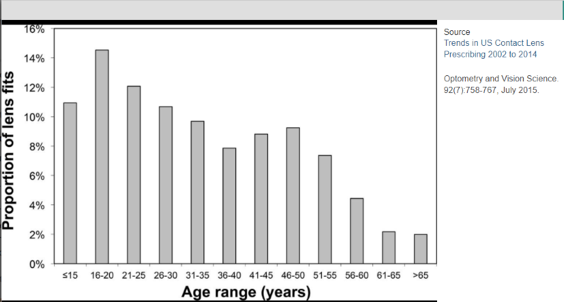Earlier this year, ABB Optical released its annual Year in Review Industry Insights on contact lenses. In it, some key points related to contact lens sales were identified:
- Daily disposable growth was up nearly 23 percent and represented 76 percent of all growth in the category in 2016.
- Growth of toric contact lenses was up 11 percent, driven predominantly by daily disposable toric lenses which were up more than 36 percent.
- Multifocals contact lenses continue to post gains with growth of nearly 17 percent. The growth was dominated by daily disposable multifocal lenses at more than 69 percent.
Does your practice mirror these statistics or are you falling behind the trend? Daily disposable lenses are the fastest growing segment of the contact lens market with subspecialty lens categories (toric and multifocal) also experiencing double digit growth. As this trend is expected to continue, take a moment now to consider whether you are taking full advantage of this growth opportunity in your own practice. Offering the best visual options, newest technology and great overall value will help spearhead growth in today’s contact lens practice.
Presbyopes Present a Significant Growth Opportunity

A study in Optometry and Vision Science evaluating contact lens prescribing trends in the United States found that fitters increasingly prefer multifocal contact lens designs to monovision fits. They concluded that the emerging preference for prescribing soft multifocal lenses versus monovision correction may relate to recent innovation in multifocal products as well as increasing prescriber confidence in those products. At the same time, the authors noted a significant drop-off in the overall percentage of contact lens wearers in age groups over 45 years old (figure above).Presbyopic patients are a largely untapped resource in terms of contact lens market share. Simply taking the time to present contact lens options as a part of your treatment plan for every presbyopic patient presents excellent growth opportunity within the patient population already in your chair.
Prescribe Full Astigmatic Correction
The authors went on to identify further growth opportunity in the toric lens market and observed that toric lenses are generally under-utilized in practice. Based on the distribution of astigmatism in contact lens wearers, they noted that if all astigmatism of at least 0.75D or 1.00D were corrected rather than prescribing spherical equivalents, then 35-45% of soft lens wearers would be in toric lenses. But in the United States, toric contact lenses represented between 25 and 30% of all soft lens fits in their survey. They concluded that US practitioners are therefore falling short of the potential that the toric soft contact lens market provides.
Deliver the Best Value
Finally, it is increasingly well established that overall value is a highly significant factor affecting patients’ healthcare decision-making – including their decision to return to your practice vs. moving on to one of your competitors. The Healthcare Management Association observed in its report on boosting profitability in healthcare institutions that consumers are having to shoulder a larger share of their own health care costs. Naturally, then, as health care becomes a more substantial out-of-pocket expense, consumers are seeking value in healthcare purchases just as they would with any other major purchase. Choose the healthiest lens options for your patients and take the time to explain the value those recommendations present. Doing so will differentiate you from other practices and build a relationship of trust with the patients you serve.CooperVision’s clariti® 1 day contact lens family offers solutions for patients across all categories –sphere, toric and multifocal – while delivering the healthier lens-wearing experience ofa silicone hydrogel material at a comparable price.For more information on clariti® 1 day family of contact lenses, visit their product page.
“The daily disposable contact lens market is very competitive, with a variety of products available for doctors to choose from. The clariti® 1-day contact lens is an excellent value: a lens that delivers higher oxygen than hydrogel materials, with all-day comfort and affordability.”

“No other 1-day lens on the market offers such variety and highperformance at a price point that - when adding in the cost of solutions and cases - is comparable to a monthly or two-week lens.”






